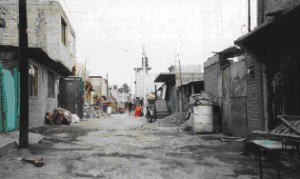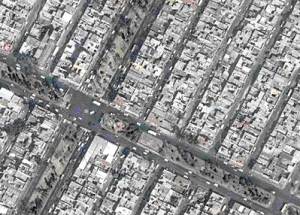With very rapid growth in the mid-20th century, inner city urban slums could not absorb all the new low income immigrants. The only viable option was so-called “irregular” housing or colonias populares. Irregular housing schemes were initiated by developers who gained ownership of large tracts of contiguous land on the urban periphery. Some of these tracts were illegally obtained ejido properties. Whether ejido or not, the tracts usually consisted of marginal lands, either prone to seasonal flooding or on very steep hillsides.
The land was subdivided into numerous small lots and sold on an installment plan to low-income families, who would construct low cost one room shacks which they called “home.” These neighborhoods were called “irregular” because many residents lacked legal deeds to their lots, their houses did not meet building codes, and they usually lacked important urban services.
Investors could not legally sell building lots without services such as water, drainage, paved streets, electricity and other basic infrastructure. However often investors did little more than mark the services on the property maps and provide “paper” services. Lots with actual services were considerably more expensive and beyond the reach of most of the urban poor. In general, local government tolerated these unserviced and illegal developments, because they helped relieve the low income housing crisis.
Developers could make fortunes with these housing schemes. In a one square kilometer piece of land they could sell up to 10,000 lots (each averaging 100 square meters, or 1076 square feet). At $200 a lot, this brought them $2 million. Developers often reneged on their promises to provide services, though their plans did at least provided vacant strips of land between lots, which became known as “paper streets”.
In the beginning, many “irregular” communities lacked running water, sewers, drainage, electricity, and public transport. However, eventually the needed services were provided and the residents upgraded their houses. After a decade or two, most of these communities became completely “regularized” with water, sewers, drainage, electricity, telephones, cable TV, retail stores, schools, bus routes, medical clinics, offices, and even movie theaters, shopping centers, and office buildings. In most large Mexican cities, roughly half of all current housing started as “colonias populares”.
Mexico’s urban geography is analyzed in chapters 21, 22 and 23 of Geo-Mexico: the geography and dynamics of modern Mexico. Buy your copy today, and read more about the fascinating history and structure of Mexico’s cities.
2 Responses to “Informal settlements or “colonias populares” in Mexico’s cities”
Sorry, the comment form is closed at this time.


Colonias like these still exist on the Texas side of the border, but many, many “homes” lack water, paved streets, electricity, sewers, etc. Various candidates, national, state, and local, make campaign promises to fix the problem, brazenly courting the Latino vote. When elected, they do nothing, and the problem continues worsening. I’m glad to know that these irregular colonias in Mexcio have been vastly improved.
Thanks, Dora, for this perspective and for the link to Texas. Almost all of the older, longer-established “colonias irregulares” in Mexico have been improved, though new ones spring up overnight. It often takes 10 years or so for them to look like a regular settlement and have some services. The first settlers starting a new irregular settlement are often referred to as paracaidistas (parachutists) in reference to the fact that they apparently come out of nowhere!